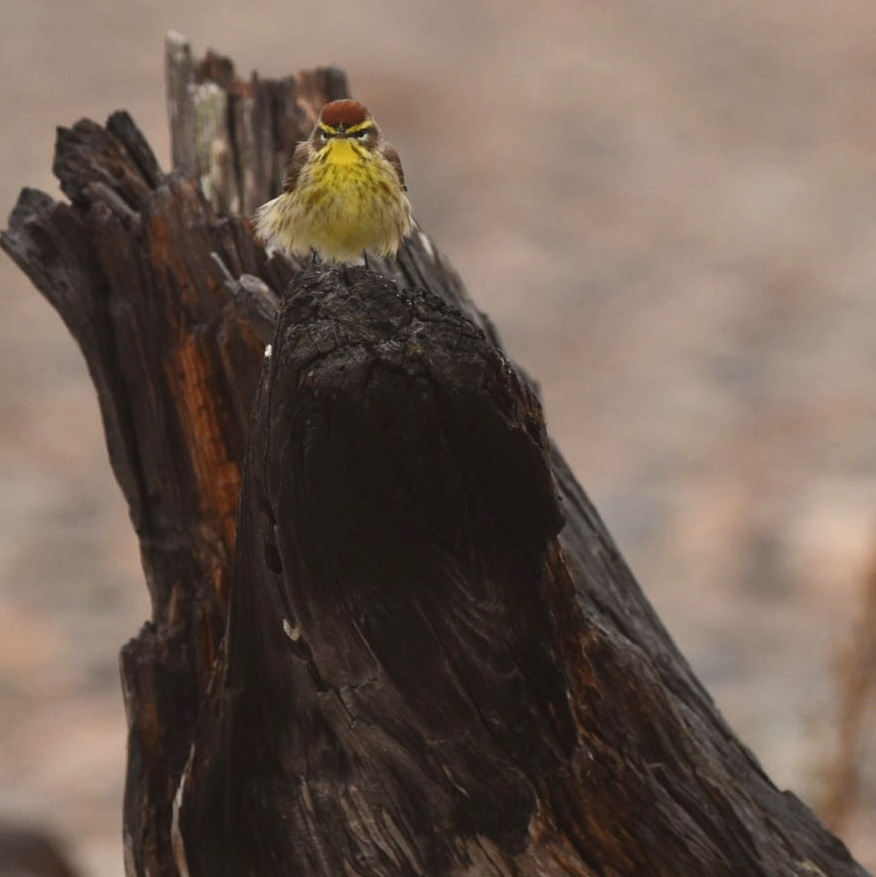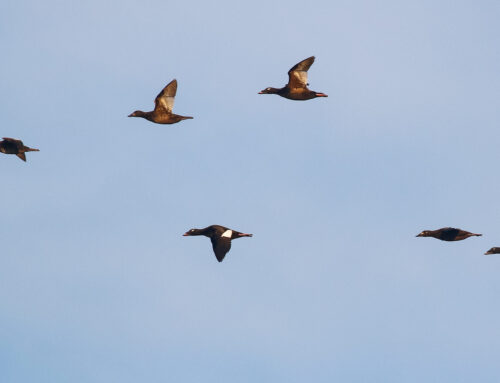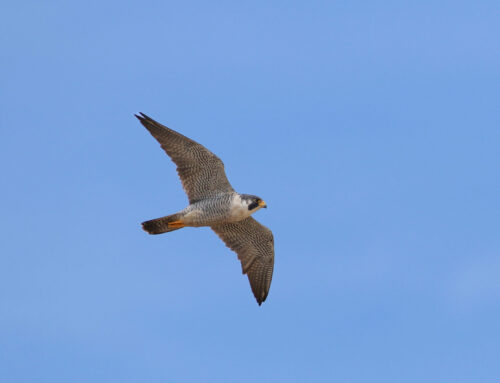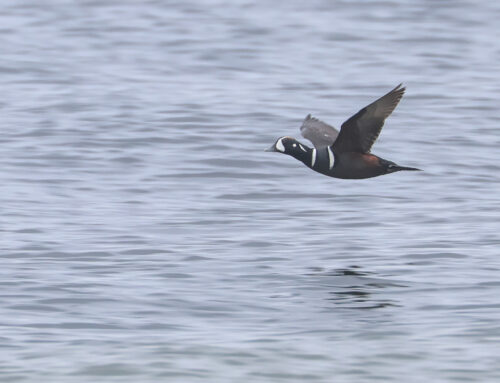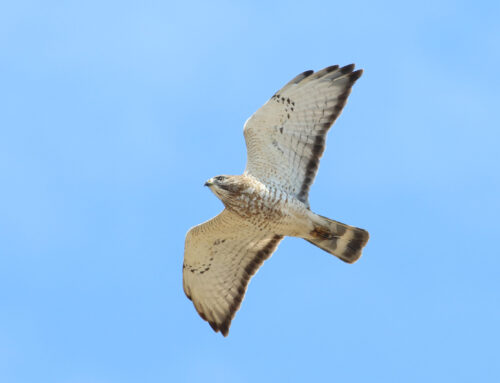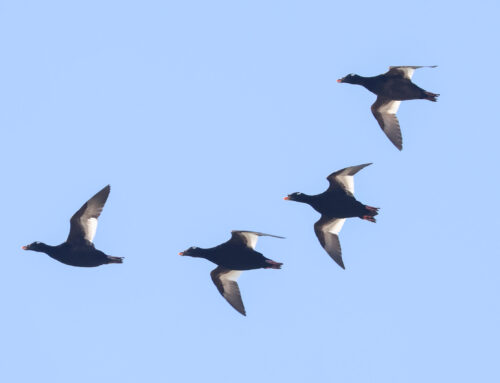There are two types of bad weather at Whitefish Point: bad weather with good birds, and bad weather with no birds. Yesterday (May 14), finally, the sky started spitting shorebirds. Yes, the sky also was spitting (and at times, pouring) 38-degree rain for the entire 8-hour count, but that is the typical tradeoff for a big shorebird day in spring here. Shorebirds as a taxa are migration champions. Many are capable of covering great swaths of continents without needing a stopover, and I think it’s plausible that at WPBO, we miss a good chunk of the sandpipers and plovers that actually pass by — it’s easy to imagine them flying high, shrugging at the expanse of water between Whitefish Point and Batchawana Bay (16 miles), and just pressing on. But the most miserable conditions (if they include a southerly wind) seem to knock shorebirds into the range where mortals can detect them. (And even then, they usually just circle the Point a few times, calling out, and cross anyway…)
During yesterday’s count period, I had my first-of-season Ruddy Turnstones and Semipalmated Sandpipers, a couple of less-common species we don’t see each spring (Pectoral Sandpiper and Long-billed Dowitcher), and large numbers of yellowlegs (60 lesser, 12 greaters, and 13 individuals that I didn’t identify to a species.) When shorebirds are in transit between their winter and summer ends of the earth, they always stir up my own yearning for movement. I guess you could say that both shorebird migration and its accompanying weather give me the chills…
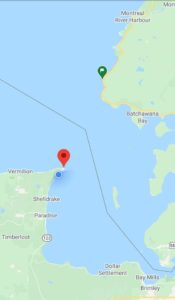
The green is where the detritus I found originated — red is Whitefish Point, where it ended up…
And, then, the bad weather without birds. We’ve had a disproportionate amount of that this spring, as you may have gathered from reading our blogs. However, though the north winds did not deposit birds, they spawned large swells that deposited some unique flotsam on the beach last Saturday. It was a piece of plastic bin that — providentially — had a man’s name on it. Like any card-carrying millennial woman, I can investigate men’s names on the internet with the best of them. So, I put my skills to use. My research brought me to a commercial fishing family from Batchawana Bay. I found the bin’s original owner on social media easily (he’s a street artist and has a public presence). Through him, I learned my beach find came from a boat that had an unfortunate incident with an ice floe in 2016 and was a total loss. (The crew, fortunately, were not.) The son owns a roadside record shop in a repurposed refrigerator trailer in Batchawana Bay. Its ambience is described as “come hang out and listen to music if you want, have a beer, and hopefully buy a record if you want.” I fully plan on making good on this once the borders open up again… (and I fully recommend you check out the links in this paragraph to learn more about the artist, the record store, and the boat mishap! I still can’t believe the story attached to my find…)
Back to the bird news, we had five American White Pelicans pass by towards the end of May 13’s count. Piping Plovers are back, as well: I’ve observed two different individuals this week, and part of our beach has closed for human use until their nesting season is complete. Please respect the plovers, a federally endangered species, by staying on the outside of the posted area, keeping dogs on a leash, and by letting your conscience guide your interactions with these charismatic species. It is the compassionate thing to do — and it is also the legal thing to do.
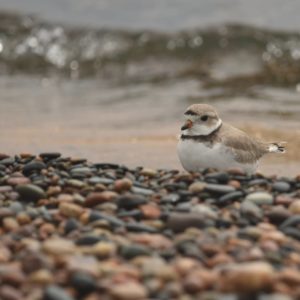
Piping Plover at WPBO. Vilag.
Now, some announcements: I will be sharing WPBO’s waterbird count through the lens of my experiences here via a presentation for American Birding Association’s Virtual Bird Club this coming Wednesday, May 20 at 8 EST. You can follow along on the ABA LIVE website, and actively participate at the ABA’s Facebook page, the ABA’s Twitter feed, and at the ABA’s YouTube channel. Next Saturday, I will be contributing to a program about Midwest migration, collaborating with Josh Engel of Red Hill Birding and Brad Bumgardner of Indiana Dunes. We’ll share that link with you as soon as it’s live; tune in if you can!
Finally, we will be holding our Birdathon later this month. Securing funding for conservation endeavors and research requires our constant energy, for we are 100% donor-funded. Even during the best of times, financing our operations requires conviction and effort, and these are not the best of times. Because of the COVID-19 virus, we have lost many of our fundraising channels. However, we’ve still got Birdathon — this event, a 24-hour birding blitz, is a huge boost towards keeping our mission-critical programs alive.
While I hesitate at the right way to ask for monetary sponsorship during the upheaval we all are enduring, I am unhesitant — and maybe even unrepentant — in my belief of the importance of WPBO’s continued research. If everyone who read this donated $10, we could likely fund a season’s worth of field crew salaries. But if the better option for you is to propagate our reach through social media, email, or your preferred medium, we solicit and are grateful for your effort on our behalf. Here is the link to my personal WPBO fundraising page.
Thank you, as always, for reading.
–Alison Vilag, Waterbird Counter
If you are considering visiting the Point, please read this important message from Michigan Audubon and WPBO Field Staff.
Maneuvering the ever-changing implications of COVID-19 has necessitated constant adaptation and evaluation for us all. Michigan Audubon and WPBO have been proactive in taking measures that protect our staff, our physical community in Paradise, and the Michigan birding community, and we have found American Birding Association’s recent guidelines on birding and social distancing a useful resource for guiding bird-related travel decisions. While there are hopeful signs that we are rounding the corner with this virus, Michigan Audubon does not want to sow precocious optimism that encourages long-distance travel. Please take a minute to read these ABA guidelines, and to imagine them through the lens of the eastern Upper Peninsula, which does not have the medical resources of Michigan’s more-developed areas. Chippewa County and its adjacent counties have just three hospitals, and only one of these has more than 100 beds; they all are at least an hour’s drive from the Point. WPBO appreciates and requests your continued conscientiousness as the season’s migration begins to ramp up, and does not condone birding travel that is not local. Keep in mind that the Owl’s Roost Gift Shop and public observation of owl banding are currently closed. In the meantime, we will virtually share the Point with you as best we can until it is safe for all parties to enjoy it together. We hope that will be soon.

